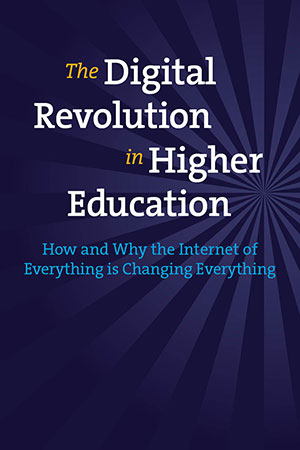The Tools of Change
Technology is fundamentally changing the practice of teaching and learning in higher education.
For years, thought leaders in higher education have warned of disruptive change looming on the horizon. And with the advent of massive open online courses, or MOOCs, many proclaimed that the forces of change had come to a head. Now that students could access high-quality courses on any topic, any time, anywhere — for free — what need would they have for a traditional college education?
Doomsdayers were convinced that professors would be replaced by video lectures. Venerable universities would crumble and shut down. Degrees would become valueless trinkets.
In reality, though, MOOCs have been less of a death sentence and more of a tool for a long-overdue revamp of the practice of teaching and learning in higher education. Innovative faculty have experimented with using MOOC content as a digital textbook, flipping the classroom by asking students to review recorded lectures in advance and reserving class time for more collaborative work. Some have run MOOCs and on-campus courses concurrently, allowing students to interact online with a global community of learners. Others have used the experience of teaching a MOOC to improve their brick-and-mortar courses, armed with new skills, technologies and techniques for engaging students. In many cases, these efforts have had a measurable, positive effect on student learning outcomes.

This piece will appear in The Digital Revolution in Higher Education: How and Why the Internet of Everything Is Changing Everything, a new book from the Public Technology Institute (find it May 1 on amazon.com).
MOOCs are just one example of technology's impact on higher education. Students today have access to a dizzying array of tools for learning — and those tools are changing all the time. Take mobile technologies, for example: About 10 years ago, Duke University redefined mobile learning by handing out iPods to its entire freshman class. A few years later, Abilene Christian University did the same with iPhones, and then with iPads. How long until every college student is wearing an Apple watch?
It's important to mention, too, that these gadgets are not merely toys for attracting students' tuition dollars — they are part of comprehensive mobile initiatives focused on enhancing teaching and learning. Curricula are redesigned to leverage mobility; mobile apps enable collaboration and learning on the go; e-textbooks provide affordable, interactive learning materials; faculty receive support and resources to change the way they teach; and results are carefully monitored to evaluate what works best.
The fact is, colleges and universities that invest in mobile learning are responding to a fundamental truth: Technology has become ubiquitous in students' everyday lives, and institutions must adapt to students' technology expectations in order to stay relevant.
According to Refuel Agency, a research firm specializing in youth and niche consumer markets, the average college student owns seven technology devices (laptops and smartphones top the list of most popular items). With the growing popularity of wearable tech, that figure could easily double in the next few years. The proliferation of devices is an opportunity not to be missed — a chance to innovate and embrace change.
Suppose a Google Glass-like product becomes the next must-have device — every college student comes to campus wearing a powerful computerized eyepiece. Students record video streams of their learning experiences, documenting their work in an immersive, authentic manner. (First-person video capture, by the way, is already happening in real-life Glass pilots at a few pioneering institutions.) Each learning moment is augmented with a visible backchannel of social media chatter or helpful information from the Web. With a flick of the wrist, a student can move learning content from his eyepiece to a larger classroom display for collaboration with peers, whether he is physically present or beaming in from afar. Faculty can tap into a rich stream of data from the devices, measuring subtle head movements, temperature changes, sleep patterns, breakfast habits and more to help determine students' comprehension of course material. Everything feeds into a limitless data repository, continuously updated and analyzed to support student success.
Is all that technology really necessary for learning? Of course not; students have passively listened to lectures for hundreds of years. But when a tool can make learning more interactive and engaging, increase access to more students, and identify and support students at risk of falling behind, it would be a shame not to use it.
About the Author
Rhea Kelly is editor in chief for Campus Technology, THE Journal, and Spaces4Learning. She can be reached at [email protected].